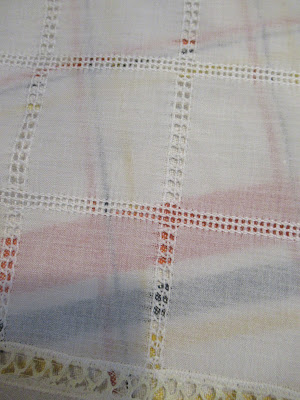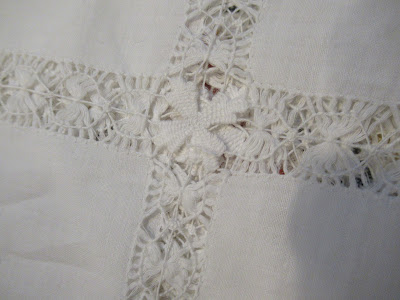My husband and I (and truth be told) mostly my husband, have been rearranging and reorganizing now that there are only two of us living here. I went through some of my treasure trove of vintage goodies. I picked these out to wash and iron and they will soon be put into rotation of use or display and other pieces that have been in heavy use will be put away to rest for a while.
Each of these pieces is charming but each one also just raises questions that I have no answer for. If any of you can solve any of these puzzles I would be really grateful-- so here they are.
Schmatta Puzzle #1
These two pieces of unbleached embroidered linen embellished with crochet lace are clearly a set. But a set of what?
I immediately thought that the smaller lozenge-shaped piece was a liner for a silver bread platter. I even had a choice of which one of my silver bread platters to use in the photo below.
If that is the case, then what is the purpose of the larger scallop-edged piece?
The green embroidery is something that can be done quickly and easily. The look of the ensemble is both casual and sophisticated. Was the larger piece meant to edge some kind of a square basket? This looks like the kind of project that appeared in a women's magazine in the early decades of the 20th century as a suggestion for a gift or perhaps something to sell at a fundraising bazaar.
Yes, this is a beautiful set. But what was it made for??
Schmatta Puzzle #2
This table topper is beautifully made out of four hankies that were crochet together. You had to baste the hankies to paper before you could start crocheting the hankies together. The lace that serves as the border is especially lovely.
Did the maker of this cloth also do the beautiful drawn thread work that makes up each individual hankie?
Table cloths that had worn through the middle were often cut into squares and then joined together with similar thread work, thus a worn-out table cloth with holes could be reborn as a new table cloth with pretty crochet work joining squares of plain or patterned linen together.
I don't quite get the point of combining four identical pristine hankies into a sweet small table cloth unless you had a crazy surplus of both hankies and time. Any ideas?
Schmatta Puzzle #3
Here is a beautiful piece of linen batiste with really wonderful drawn thread work
and pretty yet coarse embroidery. Usually, a cloth like this would be embroidered with fine smooth embroidery floss and the surface of the embroidery would be flat and low to the surface of the linen.
This combination feels a little like wearing an evening gown with a pair of Bass Weejuns. Both are good but the combination is a little bit confusing.
I believe that this piece is from the 1920s. It is a great piece of nostalgic kitsch. The text translates as "My hearth is my pride". It is embroidered on fancy woven linen. You can see the decorative bits below.
The top bit is meant to fold over.
I own several embellished pieces that are roughly the same size and all have a top flap. What were they? Were they curtains? Was it for some other use?
If you have any ideas about any of these schmatta mysteries, please let me know.
















Fascinating I have quite a few pieces of table linens from my mother ! Haven’t looked I awhile but I think there were some pieces that made me question their use/ purpose .I can’t part with them though rarely use them. maybe I could give you some?! She also had a ton of hankies She did use some but some are still in original boxes. Must have been a typical gift back in the day. I gave one to each of the female family members at her funeral. I use them occasionally and have given them to friends.
ReplyDeleteNumber 1 looks like it might be for an upholstered armchair. The large piece would be placed on the back of the chair to protect from hair products. There would be 2 of the smaller pieces, one for each armrest. The pieces could be easily washed and kept the upholstery from become stained. My grandmothers had sets on all their chairs.
ReplyDeleteSo your vote is an antimacassar set. Interesting! The large piece may be a bit short for that ( I remember those back pieces hanging down the back of the chair a bit, but perhaps it was pinned into the upholstery) Nice!!!
DeleteYes, I agree with Carolyn on the first - an antimaccassar set. There were decorative brass pins to attach them.
ReplyDeleteAs for the redwork piece, my great-aunt had open cupboards. The top, shorter ones often hid items not for display, and had short embroidered pieces hung on tiny brass rods to hide the contents. My German aunt used hers as a valance at the tiny window in the kitchen door. Piece #2 looks like a tabletopper for a living room table that held framed photos and bric-a-brac. Another great-aunt, an invalid, spent many hours chrocheting. She had a long rectangular table that held her china dog collection, and it was covered with a similar piece - 4 similar embroidered hankies crocheted together and then edged. My mom inherited it with the shelf and I used to iron it and admire the lovely work. I still have the shelf, but not the scarf.
Thank you all for your excellent answers! So all seem to be agreed that #1 is an antimacassar set missing one arm. Sue I suggest that your answer to #2 is busy work for someone who needed something to do. I am so grateful to your answer to #4. It makes perfect sense. Also all of my little valanced pieces come from folks who have German roots. I guess those little curtains were a thing in the German/Austrian home textile universe. I am glad to finally understand.
ReplyDelete